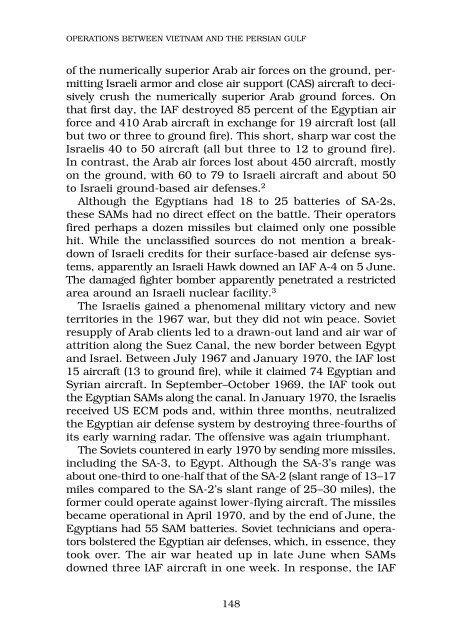Archie to SAM: A Short Operational History of Ground-Based Air ...
Archie to SAM: A Short Operational History of Ground-Based Air ...
Archie to SAM: A Short Operational History of Ground-Based Air ...
Create successful ePaper yourself
Turn your PDF publications into a flip-book with our unique Google optimized e-Paper software.
OPERATIONS BETWEEN VIETNAM AND THE PERSIAN GULF<br />
<strong>of</strong> the numerically superior Arab air forces on the ground, permitting<br />
Israeli armor and close air support (CAS) aircraft <strong>to</strong> decisively<br />
crush the numerically superior Arab ground forces. On<br />
that first day, the IAF destroyed 85 percent <strong>of</strong> the Egyptian air<br />
force and 410 Arab aircraft in exchange for 19 aircraft lost (all<br />
but two or three <strong>to</strong> ground fire). This short, sharp war cost the<br />
Israelis 40 <strong>to</strong> 50 aircraft (all but three <strong>to</strong> 12 <strong>to</strong> ground fire).<br />
In contrast, the Arab air forces lost about 450 aircraft, mostly<br />
on the ground, with 60 <strong>to</strong> 79 <strong>to</strong> Israeli aircraft and about 50<br />
<strong>to</strong> Israeli ground-based air defenses. 2<br />
Although the Egyptians had 18 <strong>to</strong> 25 batteries <strong>of</strong> SA-2s,<br />
these <strong>SAM</strong>s had no direct effect on the battle. Their opera<strong>to</strong>rs<br />
fired perhaps a dozen missiles but claimed only one possible<br />
hit. While the unclassified sources do not mention a breakdown<br />
<strong>of</strong> Israeli credits for their surface-based air defense systems,<br />
apparently an Israeli Hawk downed an IAF A-4 on 5 June.<br />
The damaged fighter bomber apparently penetrated a restricted<br />
area around an Israeli nuclear facility. 3<br />
The Israelis gained a phenomenal military vic<strong>to</strong>ry and new<br />
terri<strong>to</strong>ries in the 1967 war, but they did not win peace. Soviet<br />
resupply <strong>of</strong> Arab clients led <strong>to</strong> a drawn-out land and air war <strong>of</strong><br />
attrition along the Suez Canal, the new border between Egypt<br />
and Israel. Between July 1967 and January 1970, the IAF lost<br />
15 aircraft (13 <strong>to</strong> ground fire), while it claimed 74 Egyptian and<br />
Syrian aircraft. In September–Oc<strong>to</strong>ber 1969, the IAF <strong>to</strong>ok out<br />
the Egyptian <strong>SAM</strong>s along the canal. In January 1970, the Israelis<br />
received US ECM pods and, within three months, neutralized<br />
the Egyptian air defense system by destroying three-fourths <strong>of</strong><br />
its early warning radar. The <strong>of</strong>fensive was again triumphant.<br />
The Soviets countered in early 1970 by sending more missiles,<br />
including the SA-3, <strong>to</strong> Egypt. Although the SA-3’s range was<br />
about one-third <strong>to</strong> one-half that <strong>of</strong> the SA-2 (slant range <strong>of</strong> 13–17<br />
miles compared <strong>to</strong> the SA-2’s slant range <strong>of</strong> 25–30 miles), the<br />
former could operate against lower-flying aircraft. The missiles<br />
became operational in April 1970, and by the end <strong>of</strong> June, the<br />
Egyptians had 55 <strong>SAM</strong> batteries. Soviet technicians and opera<strong>to</strong>rs<br />
bolstered the Egyptian air defenses, which, in essence, they<br />
<strong>to</strong>ok over. The air war heated up in late June when <strong>SAM</strong>s<br />
downed three IAF aircraft in one week. In response, the IAF<br />
148
















